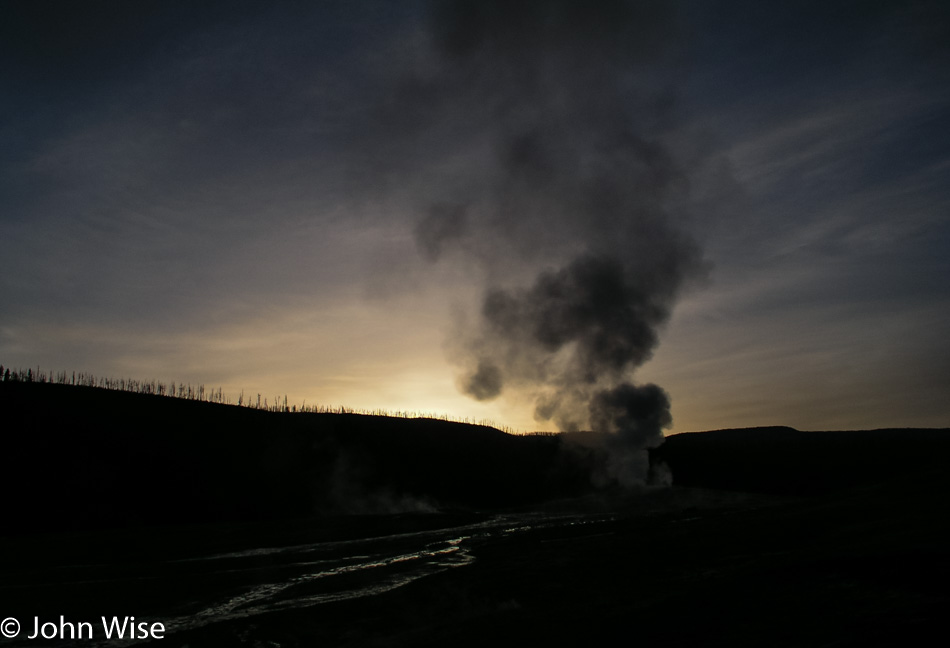
The beginning of our third full day of this 9 ½ day outing greets us with a promise of better weather. The first stop is the front desk to confirm weather conditions for the day; it looks like a repeat of the day before with a 40% chance of snow. The bad news could have been realized had we wanted to leave Yellowstone this morning, as many of the roads in and out of the park are closed. Overnight, the weather worsened, with people traveling north from the Tetons turned back due to heavy snow accumulation, as were travelers coming through the east side of the park via Cody. To the north and northeast, black ice has closed roads.
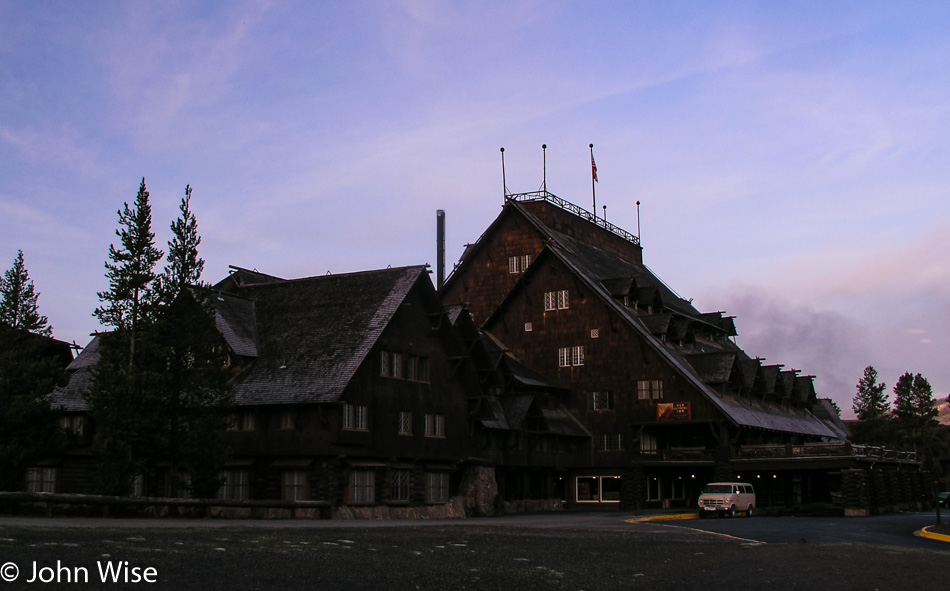
No matter for us as we are heading out the front door of Old Faithful Inn before the sun pops up on our way to explore the Upper Geyser Basin. This morning, we intend to take a long, slow meander around Old Faithful, visiting every spring and geyser we can. It remains delightfully quiet as we leave the Inn.
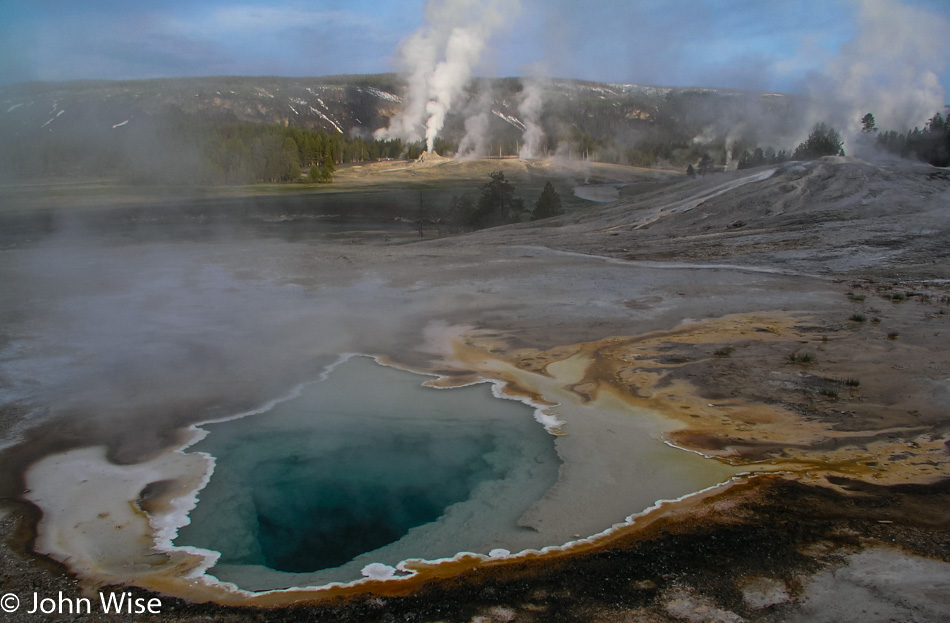
The first spring we pass on the icy trail is called Chinaman (the above photo is not that spring), named after a Chinese man who, in the 1880s, had pitched a tent over the spring and began doing laundry only to have it quickly ejected as the basket, and his soap caused the spring to act as a geyser back on that fateful day. At Chinaman Spring, I’m reminded that even the smallest spring in the shadow of one of the largest geysers is just as interesting, just as fascinating as all of the other wonders here in Yellowstone.
Update: Anyone should guess by now, here at the end of 2023, when I’m verifying blog post details, this spring has been renamed and is now the more politically correct, Chinese Spring.
While crossing the Firehole River, Old Faithful begins another eruption. By the time I make it back up the hill on the other side most of the eruption is finished; only a giant steam plume remains. We pass the quiet Giantess Geyser, a sputtering pump geyser. The Sponge Geyser busily lets off steam while its boiling waters are just out of view, quickly rising back to the surface.
Doublet Pool has an extra three-dimensionality with its miniature cliff-like relief pattern bordering its perimeter. Continuing down the boardwalk, we pass various hot springs, followed by Ear Spring and Sawmill Geyser. As we approach Beauty Pool we are shocked at its appearance as the water is nearly black. The bacterial surface has been chewed up and is white. The nearby Chromatic Pool isn’t in better shape. Before leaving the park, we forgot to ask a ranger what had happened, and I can’t find anything on their website or in the news to suggest vandalism but taking photos of these once-grand springs was out of the question. I’m hoping they simply had a ‘bad hair day’ and that on a return visit, they will have returned to their former glory.
After Beauty Pool, the boardwalk snakes through the tree line, and as it does so, we had the bejesus scared out of us when three large Bison crossed the boardwalk immediately in front of us. Seeing the Bison step up on the boardwalk let my imagination fly, and had this wooly beast charging down the boardwalk as he claimed it as his own. Instead, they were more interested in grazing and moseyed on over to better grasses.
Reaching a bend in the boardwalk, the sun has made it down to strike a geyser where, moments before, it had only been illuminating the mountains across the basin. The cold morning is perfect for watching the steam rising from springs and geysers but that steam at times wreaks havoc when we are trying to see into certain springs and geysers.
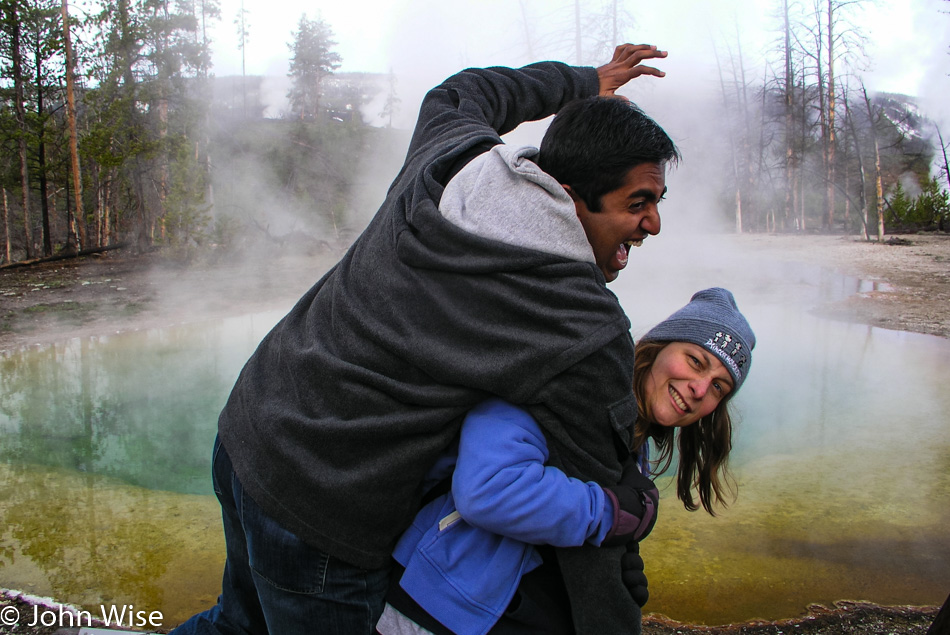
Passing over the Firehole one more time, we are closing in on our turnaround point at the wickedly impressive Morning Glory Pool. I approach with caution after having seen Beauty and Chromatic Pools not living up to their names today; I was concerned that Morning Glory may be suffering the same fate. It was not. Morning Glory truly delivers on its name; it is the most glorious hot spring of the morning thus far. Its swath of color radiates outward, starting from a deep blue to a royal aquamarine, becoming moss green before giving way to gold and orange and finally a rusty red edge.
Amidst this beautiful landscape, Jay has been murmuring to himself along the trail, “Jacuzzi…..Jacuzzi.” It was here at Morning Glory Pool that Jay was about to test the waters when Caroline, who is fully familiar with park rules on keeping clear of the sensitive grounds and features, was not going to allow Jay to foul the waters of one of our favorite locations, she grabs Jay in a flurry and throws him to the ground over her shoulder. It was an amazing sight that not only saved the hot spring from gagging on Jay but cured Jay of his incessantly annoying repeating “Jacuzzi.”
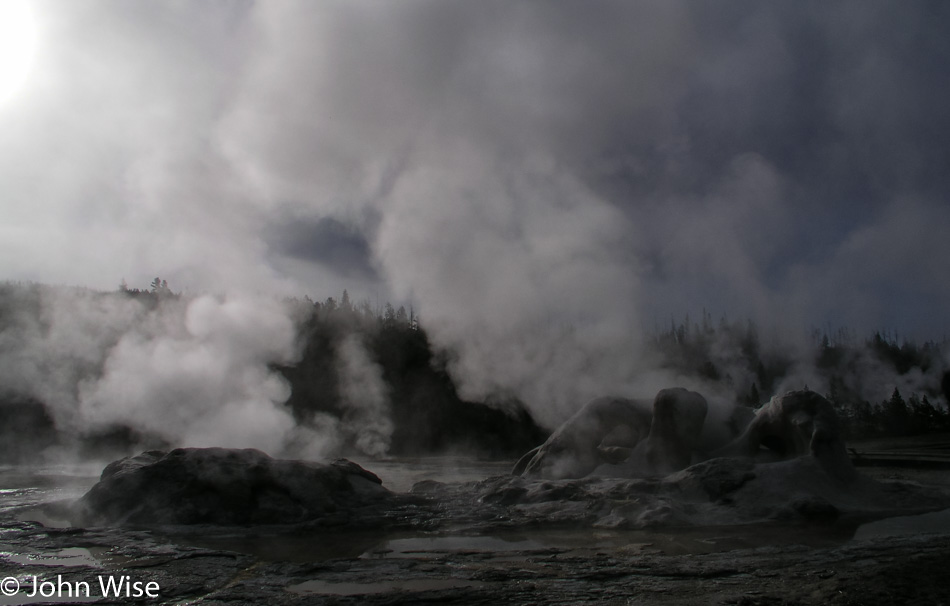
Grotto Geyser was one of our favorite geysers on our first visit to the park some years ago. Since then we’ve not had the chance to see it erupting again, a shame, as it is one of the most unique eruptions due to the shape of the grotto.
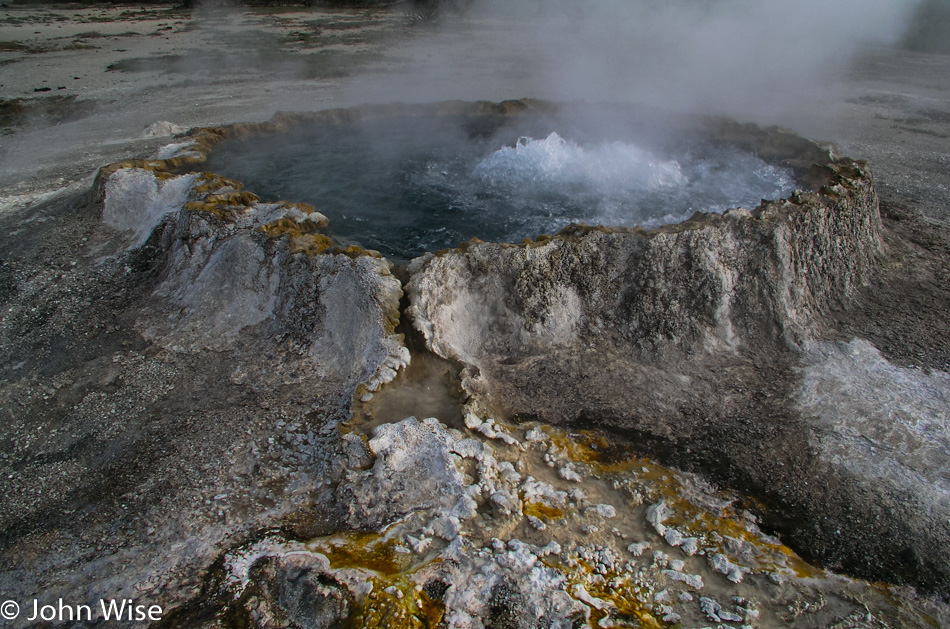
Walking back toward Old Faithful Inn we pass a few more hot springs when Caroline and I recognize we’ve never taken the trail to the Punch Bowl. Turning right at the trees reflecting in a temporary pond likely created by snowmelt, we set out to see the new sights. Daisy, Comet, and Splendid Geysers are clustered on our left, but from our perspective and their heavy steam shroud, they are difficult to gather an adequate view of. Punch Bowl Spring, on the other hand, is wonderful. The boardwalk comes right up nearly to the edge of this boiling pot. The crater rises about 30 inches off the surrounding area, with the sinter rim of the crater jutting vertically to form the cauldron, giving the spring the form that lent it its name.
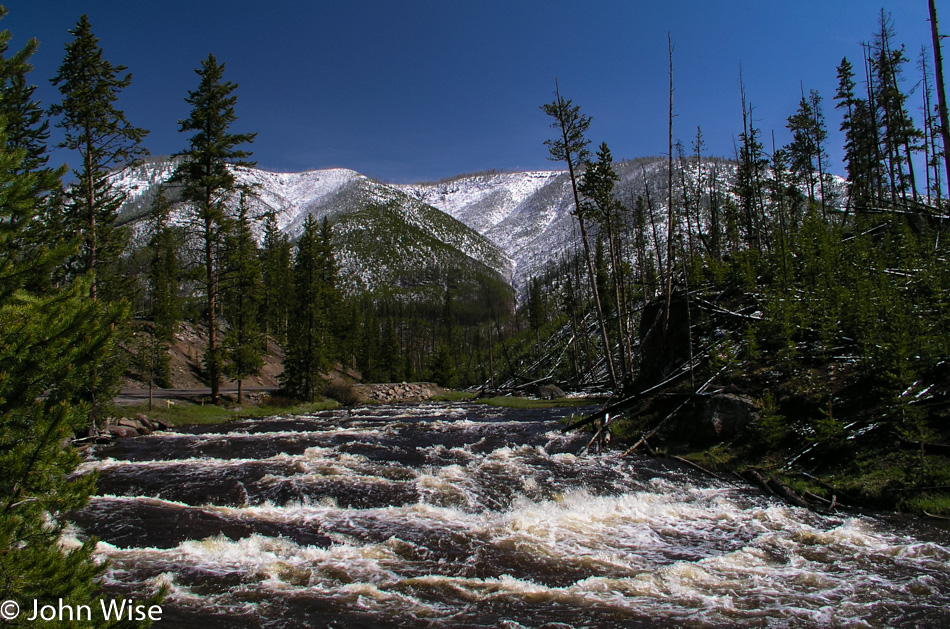
The sun is well on its way, crawling up into the sky two hours after we started this walk. We turn onto the asphalt trail that leads back to the Inn. The Firehole River cuts around small islands and glistens under the morning sun along the trail. Another unnamed spring, crystal clear except for an emerald glow near its center, enchants us while the bison just across from the spring is moving along the edge of the forest hidden in its darkness.
We step back onto a boardwalk to inspect the Castle Geyser and Crested Pool. The wind blows just enough steam away from the surface of Crested Pool for us to glimpse its waters and the boiling spot over which its waters are escaping the earth. The Castle is blowing steam but is quiet otherwise. Previous visits have made for brilliant photos of its bacteria beds, but today’s visit won’t deliver even one worthy photo.
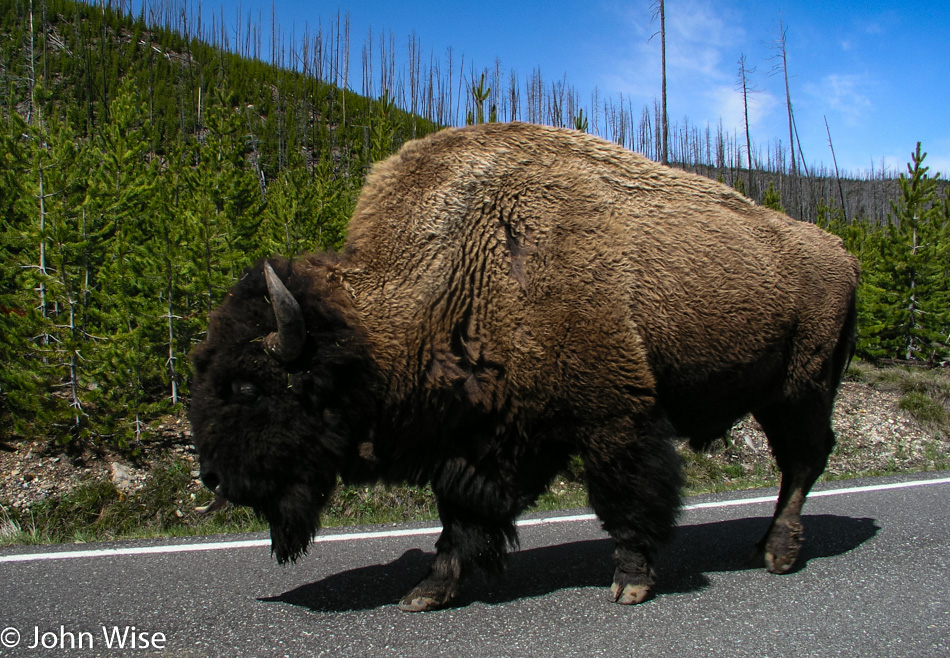
Rejoining the asphalt, the bison who’d been foraging inside the forest line emerged to join us. This is almost too close for comfort; I’m not sure if I’m more nervous for us behind the Bison or the lady walking oblivious to their approach just in front of them. Fortunately for all of us, they peel off for a nice vegetarian breakfast instead of a quick game of bowling for people.
At the Old Faithful Inn, we stop for one more moment in room 225 before checking out and hitting the gift shop. Caroline and I would have been safe from buying any more Yellowstone souvenirs had it not been for this 100th-anniversary celebration of the Old Faithful Inn. Two glasses, a refrigerator magnet, a tin of mints, postcards, and a Yellowstone poncho for Jay, and we are sadly leaving.
Gas prices at Old Faithful are as reasonable as anywhere else, cheaper as a matter of fact than some other places we’ve already been. The odometer tells us we’ve traveled 1,483 of a planned 5,014 miles. The Impala, which our rental agency thought they were doing us a favor in upgrading us to, is, in fact, a curse as we are getting significantly fewer miles per gallon than we would have with the midsize car we reserved. But we get something better than lower gas prices here, we get another White Chocolate Caramel Cappuccino. Last night, as we left Mammoth, we stopped at the gas station there for some coffee, with Caroline opting for the Cappuccino. Lucky for Jay and me, Caroline was willing to share; unlucky for Caroline, she couldn’t have had more than a third of that cup for herself; today, we all have our own large cup of sweet yumminess!
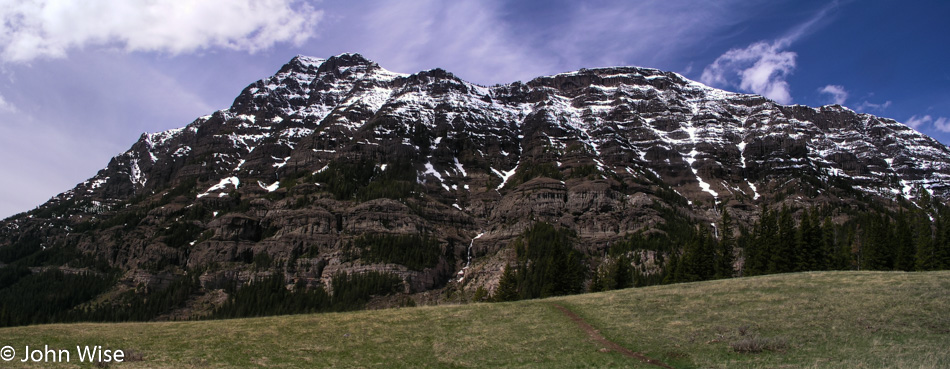
Now it’s time to go with some haste to our next lodging, which is in Beach, North Dakota, nearly 600 miles away. We make a quick stop at Gibbon Falls to let Jay sit next to the rushing water; after having spent the past years in the desert, he has a special affinity for waterfalls. We continue our march northeast, stopping to give one very large Bison bull a full breadth. Such an impressive, peaceful-looking creature! But of course, we are aware looks can be deceiving as we cross our fingers that our bright red car doesn’t challenge this giant.
Back through meadows and over rivers, we make our to Mammoth Hot Springs for another check on the weather and what conditions look like over Chief Joseph Pass. We get an all-clear and will soon be leaving the Yellowstone wilderness after another incredible visit. As we pass through the Lamar Valley, by the Lamar River, the Absaroka Range of mountains rises up to lend yet more beauty to this incredible landscape. Craggy snow-capped mountains surround us, with the forest coming back to life after a long winter.
When you leave the park, the first noticeable sign that you have left is the quality of the road. For all the budget cuts the parks suffer from, the roads are almost always better maintained than the state roads, and these are winter-abused roads. Bouncing along, avoiding potholes, we pass through Cooke City, wishing Highway 212, cutting through the snow-covered Beartooth Pass, would magically open today. It doesn’t, and we drive as planned over the Chief Joseph Scenic Highway.
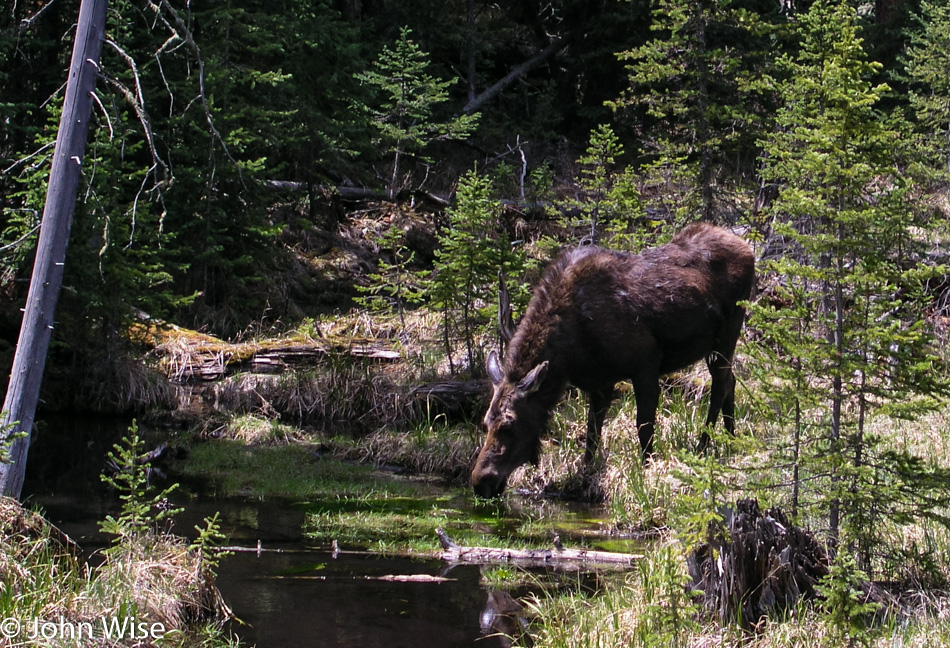
Outside of Cooke City but not yet on the Chief Joseph Highway, we stop for what might be our last encounter with snow, a patch knee-deep and still powdery. Back on the road, Jay excitedly blurts out that he saw something next to the road and that we need to turn around. It’s a moose. That moose stood streamside drinking the entire time we parked and watched it. He’d look up at us and then continue drinking. It was so quiet in these mountains we could listen to each slurp that moose made; he was still slurping as we drove off.
Leaving the jagged mountains behind us, we drive the winding road of the scenic highway through the Shoshone National Forest that blankets this segment of the Rocky Mountains. With an abundance of grasses and sage now part of the landscape, the mountains begin to recede, and we glimpse our first sight of the Great Plains. The change is abrupt and dramatic. Caroline and I both feel some anguish coming from the backseat as Jay can easily see that what lies ahead of us will be devoid of waterfalls and alpine meadows. A final jutting escarpment points its red cliff face in the direction where larger mountains grow, the opposite direction of our travels.
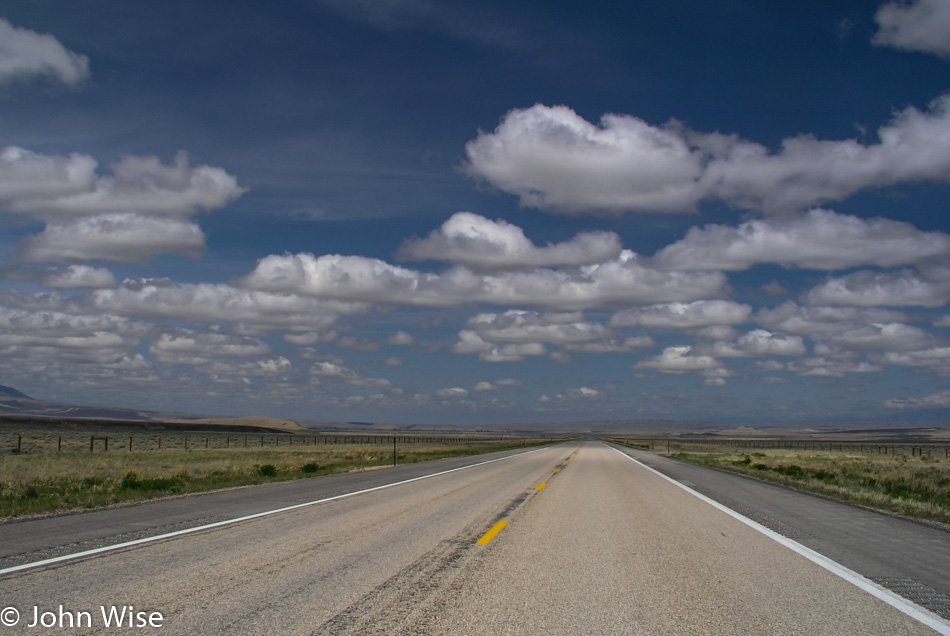
Flat Land. This is the Great Plains. This is where we wanted to be. After reading The Essential Lewis and Clark by Landon Jones and The Great Plains by Ian Frazier and having been to so many other locations across America where Lewis and Clark went before us, the time has come for us to experience the Great Plains for ourselves.
The Clarks Fork of the Yellowstone River is our first river crossing; unfortunately, we can find no place to drop down to the shoreline to make a stand in the river. The sky is expansive now that we are out of the mountains. Montana is just minutes away. While no mountains rise up on the horizon, we all notice that this is nowhere near as flat as we had expected. The hills are rolling, the clouds are low, and stretch for 50 miles in all directions. The tan grasses are making way for new green growth. Shadows race over hills. The Great Plains are beautiful.
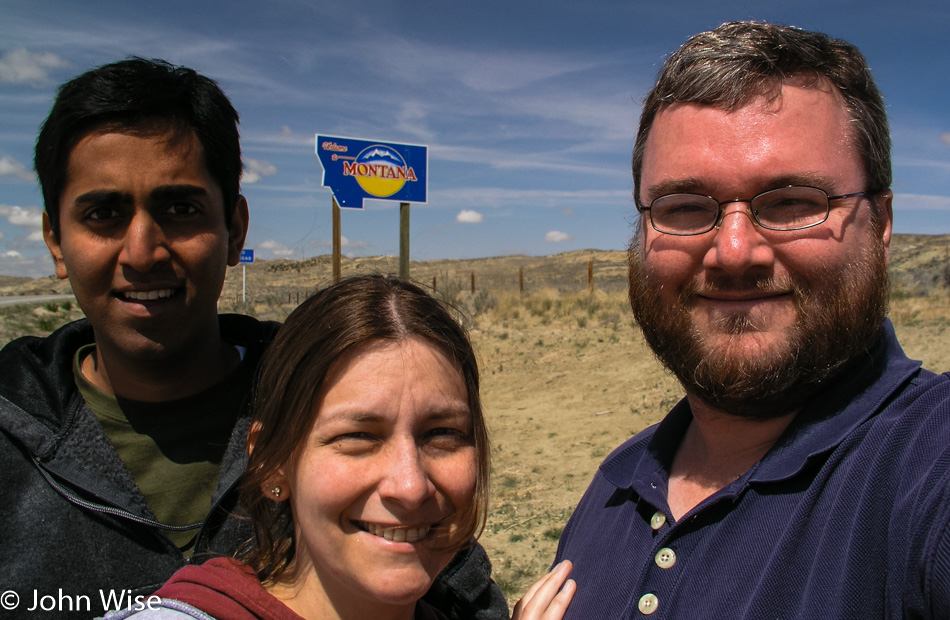
We had left Yellowstone around noon and crossed into Montana near 3:00 p.m., it was almost 5:00 p.m. as we entered the Little Bighorn Battlefield National Monument. Out in the middle of nowhere, well beyond the cities of any meaningful population, a battle took place here at Crow Agency back in 1876. As if to mark this solemn place where many a life perished, the clouds have moved in to cast their shadow on these now hallowed grounds.
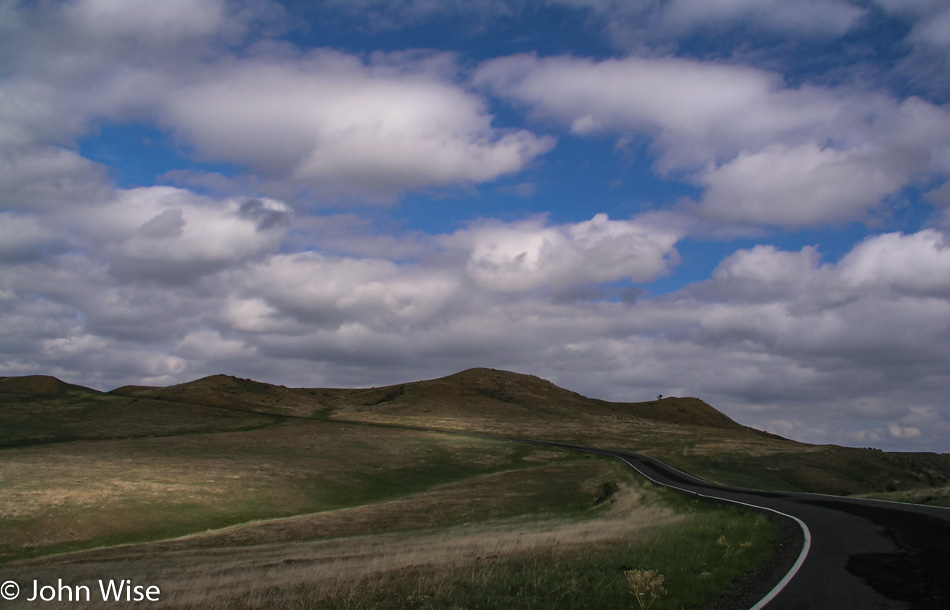
The road that slices a path through the Battlefield is well placed, offering a unique overview of the lands that the highway below can’t offer. To our sides, the occasional wild horse grazes. Light and shadow dance over grasses and hills, demonstrating that even the veil of shadows in this wide-open space does little to hide anything, and with no cover, this would appear not to be a very logical place to hold a fight. Then pit 1,500 warriors, patriots fighting for their homeland against an invading force of 262 and it’s easy to see why this became a giant cemetery.
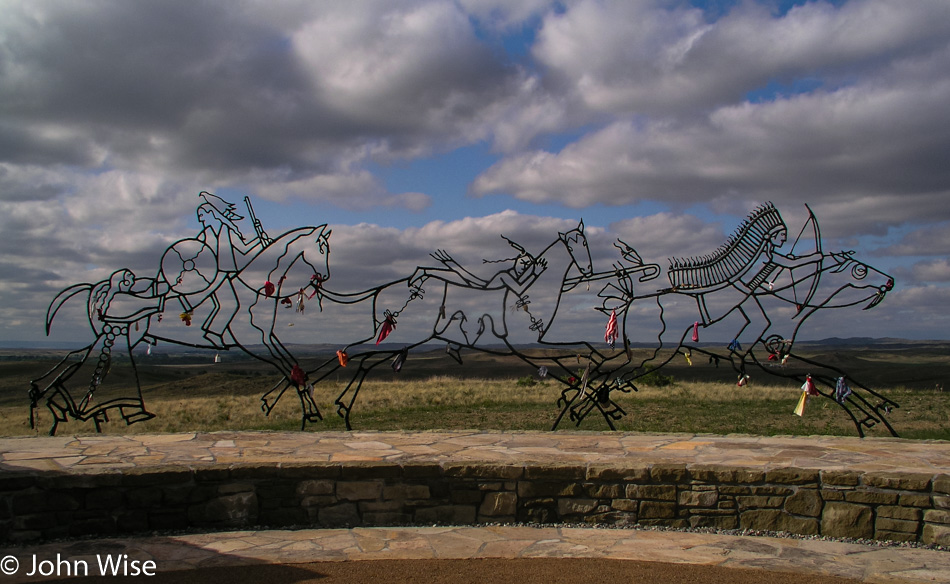
Considering the details of what happened at Little Bighorn, I’m ambivalent about this being a National Monument. A nod to stupidity might be more in order or a monument to the suffering of Native Americans. But I am in America, where we are as likely to celebrate the accomplishments of Bonnie and Clyde, John Dillinger, and Al Capone as we are to celebrate Millard Fillmore, Benjamin Franklin, or Thomas Edison. So celebrating a General defending the American way no matter how misguided the Officer, sounds good, so we do it.
The battlefield itself stretches from side to side next to the five-mile-long road that bisects it. That one group of soldiers wouldn’t know what another group was encountering just a quarter-mile away is apparent, as the hills couldn’t be more effective in isolating the battling soldiers. There is no ideal vantage point to see the movements of those below, behind, or to the side. When Custer divided his men, it is now obviously a recipe for disaster for the observers who can whoosh by in their cars.
The site has a memorial to the Native Americans who fought here and lost their lives here. There’s also a monument to the white men who lost their lives, along with a graveyard that includes a marker for Custer, whose remains are actually buried at West Point. The museum is still an homage in reference to the park’s former name, the Custer Battlefield National Monument. There are many an artifact from Custer himself, his sword, a jacket, a trunk, a cap, and a few other mementos. The museum also has a nice collection of historic U.S. cavalry pieces found on the battlefield but has very little information or historical pieces from the 1,500 Native Americans who fought there.
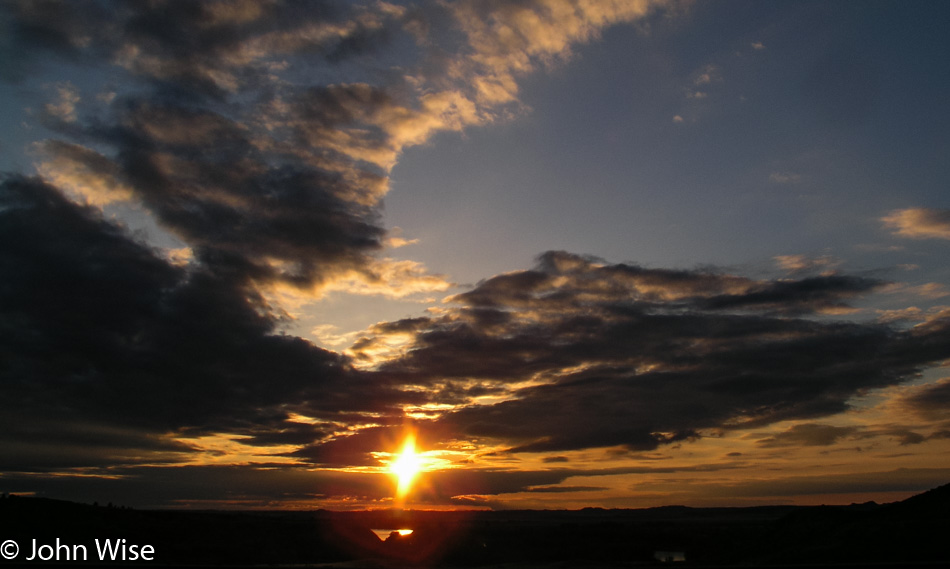
Of the more than 115 National Parks and Monuments Caroline and I have visited, this one ranks below everything else. We leave the park, and but for a few rays of sun poking through the clouds, it is as dark as my feelings about the monument we just left.
Down the road, the cloud cover breaks apart; this country is open and gorgeous. Not too far out of Colstrip, Montana, we join Interstate 94, another of our brief encounters with a major highway. At 7:30 we pull off the highway in the small town of Forsyth to find access to the Yellowstone River. Shoes off, feet in, it is standing in the river time. A few more miles down the road, and the setting sun shines off the Yellowstone River, we are still 90 minutes away from our motel. Gas up in Wibaux, cross the border without a photo opportunity, and pull into the very small town of Beach, North Dakota. Tonight, we sleep at the Westgate Motel for only $44; it’s 10:00 p.m.